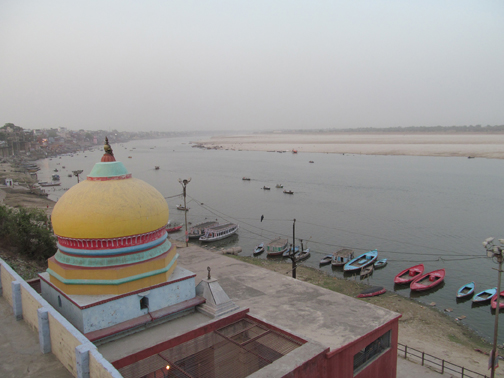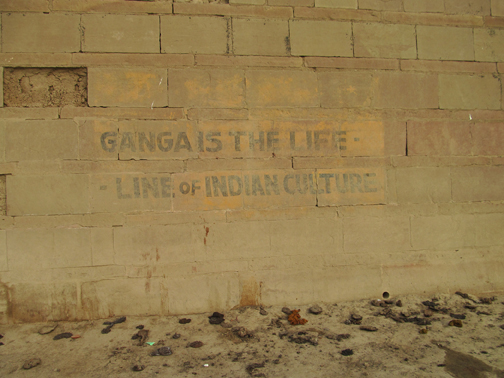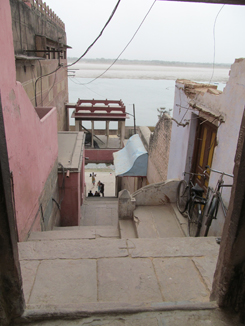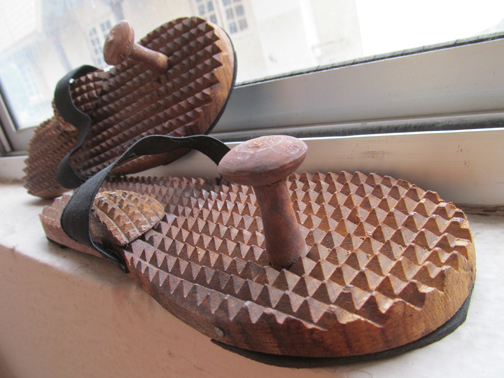David Stairs

The Ganges looking north
Benares. Varanasi in modern parlance. This is the holiest city of Hinduism. The Ganges runs through it like the rainbow bridge of Asgard, but it’s so much more useful to the common man.

I’d not really seen India ’til I came to Benares. Here there are so many bicycle rickshaws and the traffic is so chaotic that all the autoricks need custom bumper and blinker guards. The streets are jammed with people walking, riding, pushing, pulling, honking, and being patient, a commercial circus right in the street.


The Old City is off limits to cars and trucks. You have to look out for bikes and motorcycles, and an occasional autorickshaw, but otherwise, the alleys are given over to pedestrians and people moving loads of goods by human power.


And what alleys they are! Narrow and winding, they snake in various directions, but generally follow the bend of Ganga, with frequent stairways leading down to the ghats on the river. Lined with small shops, some barely closet size, a local resident would not need to venture very far from his apartment to satisfy every need.

My new “meat tenderizer” vedic sandals
Here people sell vegetables and dry goods, fry snack food and boil fondant for sweets, sit with covered vats of yogurt and sell notions. I found my pictures of Hanuman and Kali here. I also purchased a pair of spiked wooden sandals that are supposed to be good for what ails me, but are almost impossible to stand in. Bells are never out of earshot, and the indigent sit outside the temples waiting for alms.
Elderly people climb the 75 steps up from the river to their homes, returning from morning ablutions and prayer. Some live in very straitened circumstances. A space eight feet square rents for 1500 rupees per month, or about $360 a year.


At left, a man in his small room. On the right, stone steps
Buildings are a cacaphony of styles and materials, but mostly brick and cement. All of the old principalities of medieval Hindustan built palaces along the waterfront, here Bihar, there Delhi, and again Hyderabad. These fortress-like structures dominate the ghats in a modest, latter-day display of ostentation, their days of glory long past.


A palace on the river; sleeping on a boat
Complex security measures to lock up shops and guesthouses are balanced by sweet design solutions, like two simple stone steps up to a doorway. Priests with painted faces wearing orange robes mingle with tourists in the passageways, everyone seeming to have somewhere to go.

A small turquoise prayer wheel


Benares fan at center left; Ganesh locks us with good luck, center right

Temple gong
On the water, boats ply the river in both directions, encouraged by the gentle current of low flow season. The daytime temperature in June can exceed 115°f, and the humidity is crushing. Everyone needs a fan. By 8am it’s already hot, and many people have spent the night sleeping outside on everything from porches to boats in an effort to beat the heat.

Dawn at Kedawar Ghat
At Manikarnata, the main burning ghat, smoke issues from pyres and heaps of logs are stored both onshore and on boats. Families gather to give last rites to their loved ones, paying as much as they can afford for wood, each piece carefully accounted for. In the background, the sick and dying stay in hospices, quietly awaiting their date with destiny.

The main burning ghat of Benares
Each night, at Daraswamedh Ghat, priests conduct an elaborate purification ritual, complete with music, bells, singing, incense, and sacred offerings while hundreds of tourists sit in boats just offshore, gawking at the colorful ceremony.

Night time public purification ceremony
Overall, in a city where so much effort is focused on religion, design tends to favor the sacred, from murals of Shiva to temple architecture to, yes, even padlocks. And in a place where the sense of faith is this pervasive, even an old heathen like myself can be moved to amazement.
David Stairs is the founding editor of Design-Altruism-Project











Leave a Reply
You must be logged in to post a comment.